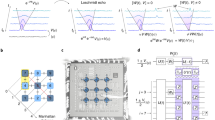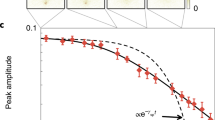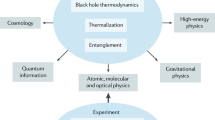Abstract
In relativistic quantum field theory, information propagation is bounded by the speed of light. No such limit exists in the non-relativistic case, although in real physical systems, short-range interactions may be expected to restrict the propagation of information to finite velocities. The question of how fast correlations can spread in quantum many-body systems has been long studied1. The existence of a maximal velocity, known as the Lieb–Robinson bound, has been shown theoretically to exist in several interacting many-body systems (for example, spins on a lattice2,3,4,5)—such systems can be regarded as exhibiting an effective light cone that bounds the propagation speed of correlations. The existence of such a ‘speed of light’ has profound implications for condensed matter physics and quantum information, but has not been observed experimentally. Here we report the time-resolved detection of propagating correlations in an interacting quantum many-body system. By quenching a one-dimensional quantum gas in an optical lattice, we reveal how quasiparticle pairs transport correlations with a finite velocity across the system, resulting in an effective light cone for the quantum dynamics. Our results open perspectives for understanding the relaxation of closed quantum systems far from equilibrium6, and for engineering the efficient quantum channels necessary for fast quantum computations7.
This is a preview of subscription content, access via your institution
Access options
Subscribe to this journal
Receive 51 print issues and online access
$199.00 per year
only $3.90 per issue
Buy this article
- Purchase on Springer Link
- Instant access to full article PDF
Prices may be subject to local taxes which are calculated during checkout



Similar content being viewed by others
References
Lieb, E. H. & Robinson, D. W. The finite group velocity of quantum spin systems. Commun. Math. Phys. 28, 251–257 (1972)
Bravyi, S., Hastings, M. B. & Verstraete, F. Lieb–Robinson bounds and the generation of correlations and topological quantum order. Phys. Rev. Lett. 97, 050401 (2006)
Calabrese, P. & Cardy, J. Time dependence of correlation functions following a quantum quench. Phys. Rev. Lett. 96, 136801 (2006)
Eisert, J. & Osborne, T. J. General entanglement scaling laws from time evolution. Phys. Rev. Lett. 97, 150404 (2006)
Nachtergaele, B., Ogata, Y. & Sims, R. Propagation of correlations in quantum lattice systems. J. Stat. Phys. 124, 1–13 (2006)
Polkovnikov, A., Sengupta, K., Silva, A. & Vengalattore, M. Nonequilibrium dynamics of closed interacting quantum systems. Rev. Mod. Phys. 83, 863–883 (2011)
Bose, S. Quantum communication through spin chain dynamics: an introductory overview. Contemp. Phys. 48, 13–30 (2007)
Hastings, M. B. Lieb–Schultz–Mattis in higher dimensions. Phys. Rev. B 69, 104431 (2004)
Nachtergaele, B. & Sims, R. Much ado about something: why Lieb–Robinson bounds are useful. Preprint at http://arXiv.org/abs/1102.0835 (2011)
Nachtergaele, B. & Sims, R. Lieb–Robinson bounds and the exponential clustering theorem. Commun. Math. Phys. 265, 119–130 (2006)
Hastings, M. B. & Koma, T. Spectral gap and exponential decay of correlations. Commun. Math. Phys. 265, 781–804 (2006)
Eisert, J., Cramer, M. & Plenio, M. B. Area laws for the entanglement entropy. Rev. Mod. Phys. 82, 277–306 (2010)
Läuchli, A. M. & Kollath, C. Spreading of correlations and entanglement after a quench in the one-dimensional Bose–Hubbard model. J. Stat. Mech. P05018 (2008)
Nachtergaele, B., Raz, H., Schlein, B. & Sims, R. Lieb–Robinson bounds for harmonic and anharmonic lattice systems. Commun. Math. Phys. 286, 1073–1098 (2009)
Cramer, M., Serafini, A. & Eisert, J. in Quantum Information and Many Body Quantum Systems Vol. 8 (eds Ericsson, M. & Montangero, S. ) 51–72 (Edizioni della Normale, Pisa, 2008)
Eisert, J. & Gross, D. Supersonic quantum communication. Phys. Rev. Lett. 102, 240501 (2009)
Bloch, I., Dalibard, J. & Zwerger, W. Many-body physics with ultracold gases. Rev. Mod. Phys. 80, 885–964 (2008)
Bakr, W. S., Gillen, J. I., Peng, A., Folling, S. & Greiner, M. A quantum gas microscope for detecting single atoms in a Hubbard-regime optical lattice. Nature 462, 74–77 (2009)
Sherson, J. F. et al. Single-atom resolved fluorescence imaging of an atomic Mott insulator. Nature 467, 68–72 (2010)
Fisher, M. P. A., Weichman, P. B., Grinstein, G. & Fisher, D. S. Boson localization and the superfluid-insulator transition. Phys. Rev. B 40, 546–570 (1989)
Jaksch, D., Bruder, C., Cirac, J. I., Gardiner, C. W. & Zoller, P. Cold bosonic atoms in optical lattices. Phys. Rev. Lett. 81, 3108–3111 (1998)
Kühner, T. D., White, S. R. & Monien, H. One-dimensional Bose–Hubbard model with nearest neighbor interaction. Phys. Rev. B 61, 12474–12489 (2000)
Endres, M. et al. Observation of correlated particle-hole pairs and string order in low-dimensional Mott insulators. Science 334, 200–203 (2011)
Daley, A. J., Kollath, C., Schollwöck, U. & Vidal, G. Time-dependent density-matrix renormalization-group using adaptive effective Hilbert spaces. J. Stat. Mech. P04005 (2004)
White, S. R. & Feiguin, A. E. Real-time evolution using the density matrix renormalization group. Phys. Rev. Lett. 93, 076401 (2004)
Kollath, C., Schollwöck, U., von Delft, J. & Zwerger, W. One-dimensional density waves of ultracold bosons in an optical lattice. Phys. Rev. A 71, 053606 (2005)
Kibble, T. W. B. Topology of cosmic domains and strings. J. Phys. Math. Gen. 9, 1387–1398 (1976)
Zurek, W. H. Cosmological experiments in superfluid helium? Nature 317, 505–508 (1985)
Schollwöck, U. The density-matrix renormalization group in the age of matrix product states. Ann. Phys. 326, 96–192 (2011)
Vidal, G. Classical simulation of infinite-size quantum lattice systems in one spatial dimension. Phys. Rev. Lett. 98, 070201 (2007)
Acknowledgements
We thank C. Weitenberg and J. F. Sherson for their contribution to the design and construction of the apparatus. We also thank D. Baeriswyl, T. Giamarchi, V. Gritsev and S. Huber for discussions. C.K. acknowledges previous collaboration on a related subject with A. Läuchli. We acknowledge funding by MPG, DFG, EU (NAMEQUAM, AQUTE, Marie Curie Fellowship to M.C.), JSPS (Postdoctoral Fellowship for Research Abroad to T.F.), ‘Triangle de la physique’, ANR (FAMOUS) and SNSF (under division II and MaNEP). Financial support for the computer cluster on which the calculations were performed was provided by the Fondation Ernst et Lucie Schmidheiny.
Author information
Authors and Affiliations
Contributions
M.C. performed the experiment. P.B. performed the numerical simulations. P.B., D.P. and C.K. developed the analytical model. M.C. and P.B. carried out the data analysis. All authors contributed to designing the study, to interpreting the data and to writing the manuscript.
Corresponding author
Ethics declarations
Competing interests
The authors declare no competing financial interests.
Supplementary information
Supplementary Information
This file contains Supplementary Text and Data including a Supplementary Discussion, Supplementary Figures 1-2 with legends, Supplementary Tables 1-2 and additional references. (PDF 319 kb)
Rights and permissions
About this article
Cite this article
Cheneau, M., Barmettler, P., Poletti, D. et al. Light-cone-like spreading of correlations in a quantum many-body system. Nature 481, 484–487 (2012). https://doi.org/10.1038/nature10748
Received:
Accepted:
Published:
Issue Date:
DOI: https://doi.org/10.1038/nature10748
This article is cited by
-
Speed limit of quantum metrology
Scientific Reports (2023)
-
Many-body quantum chaos in stroboscopically-driven cold atoms
Communications Physics (2023)
-
Quantum simulations with ultracold atoms in optical lattices: past, present and future
Journal of the Korean Physical Society (2023)
-
Quantum wake dynamics in Heisenberg antiferromagnetic chains
Nature Communications (2022)
-
Tensor-network study of correlation-spreading dynamics in the two-dimensional Bose-Hubbard model
Communications Physics (2022)
Comments
By submitting a comment you agree to abide by our Terms and Community Guidelines. If you find something abusive or that does not comply with our terms or guidelines please flag it as inappropriate.



